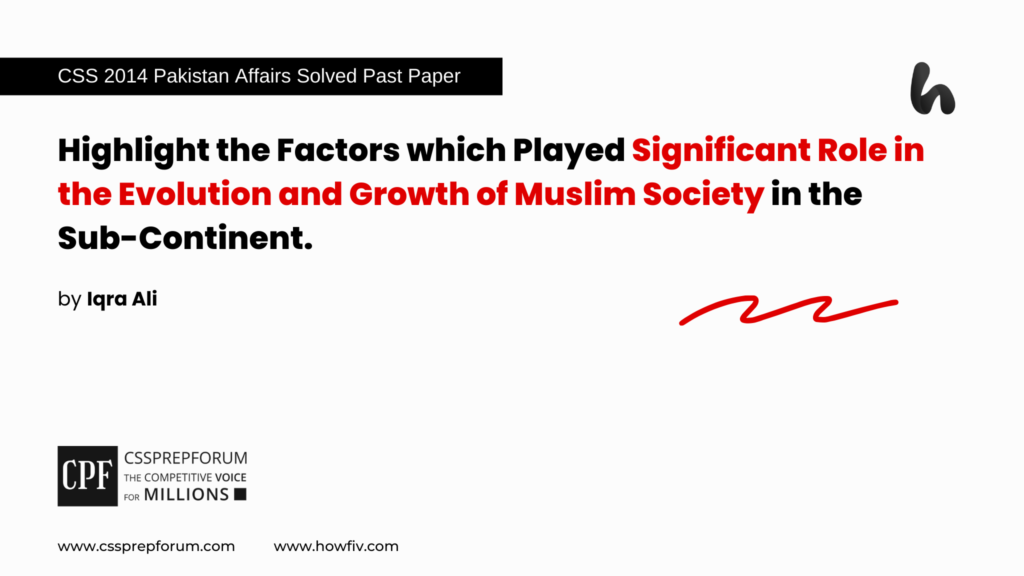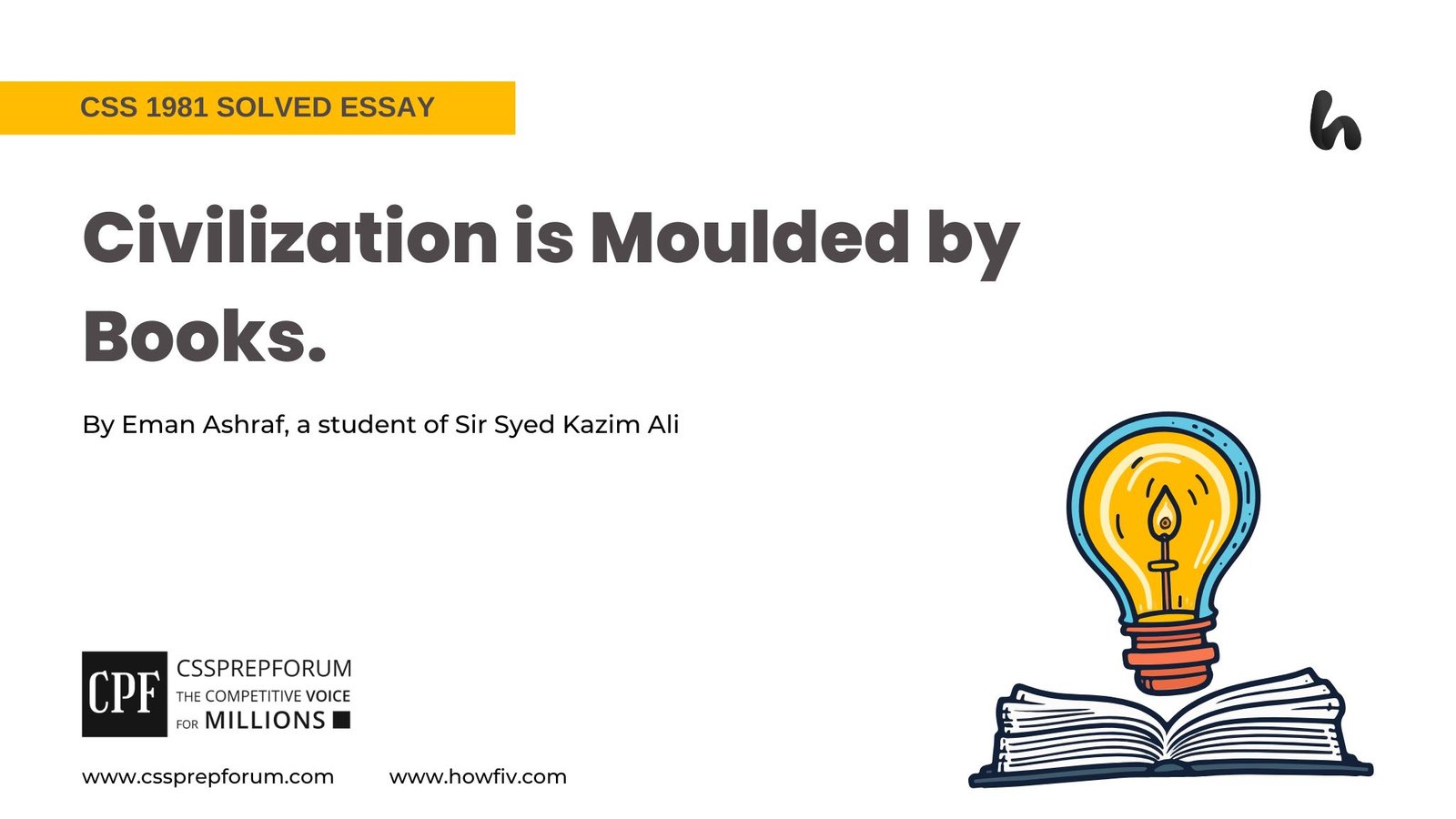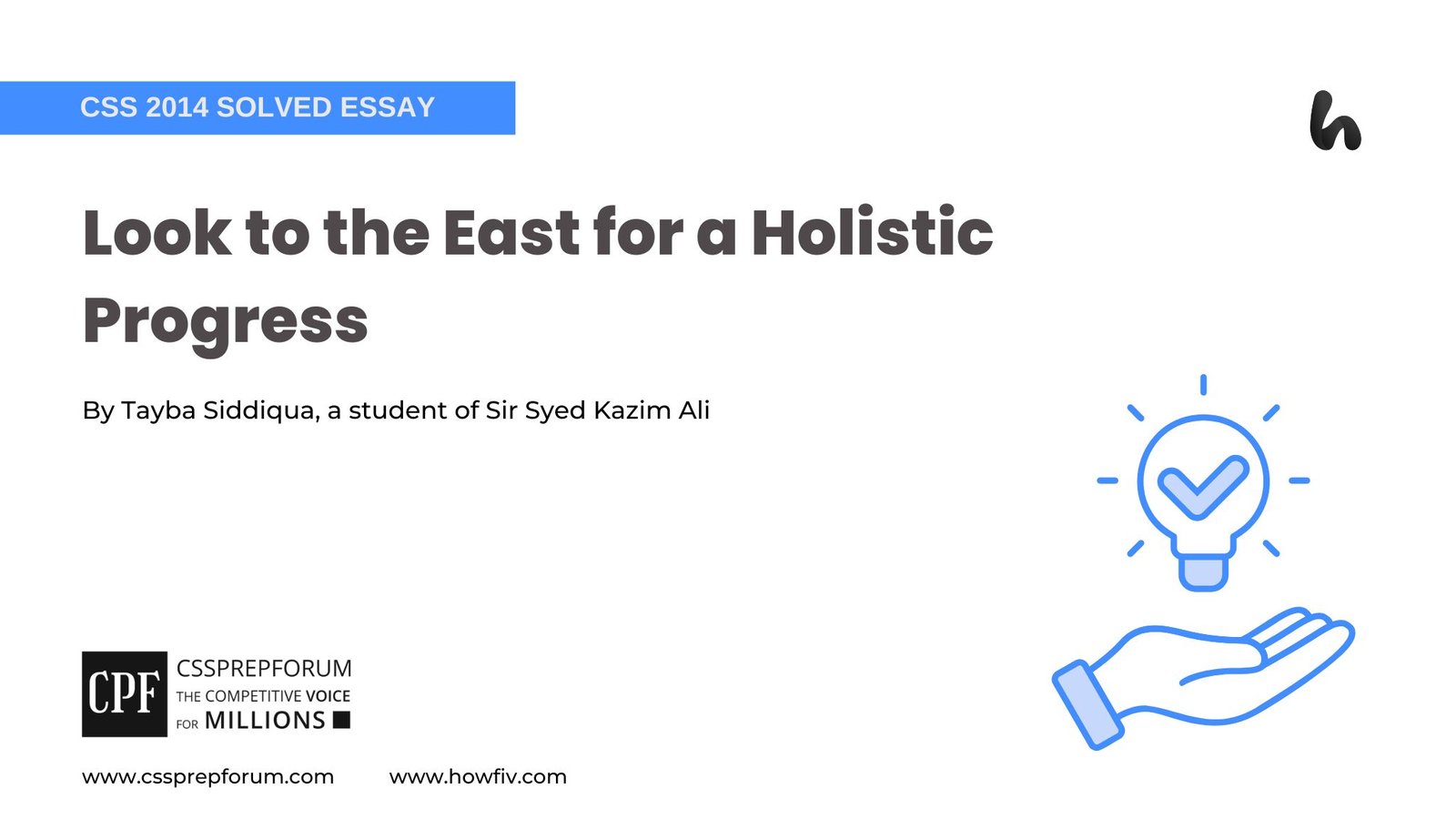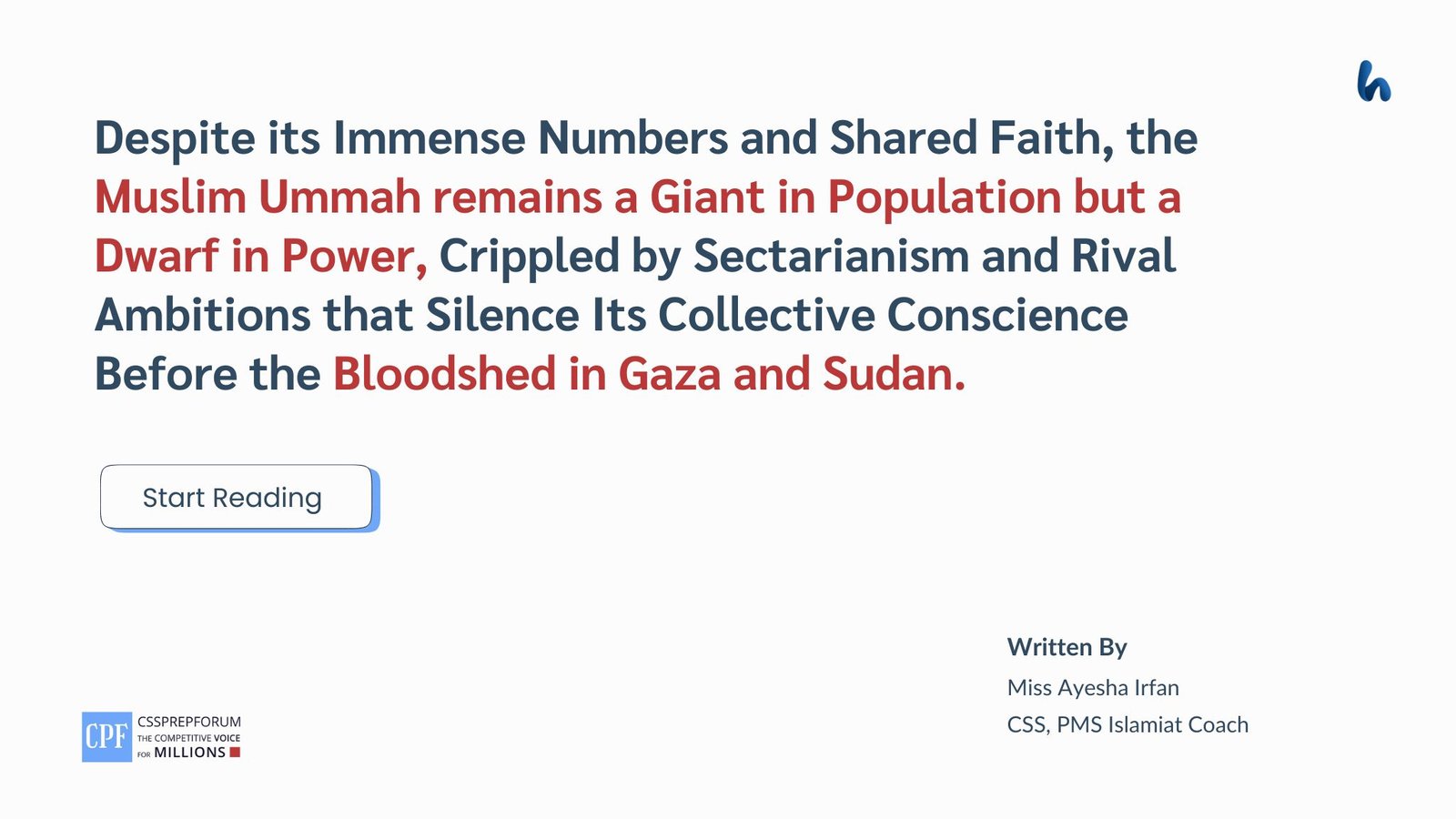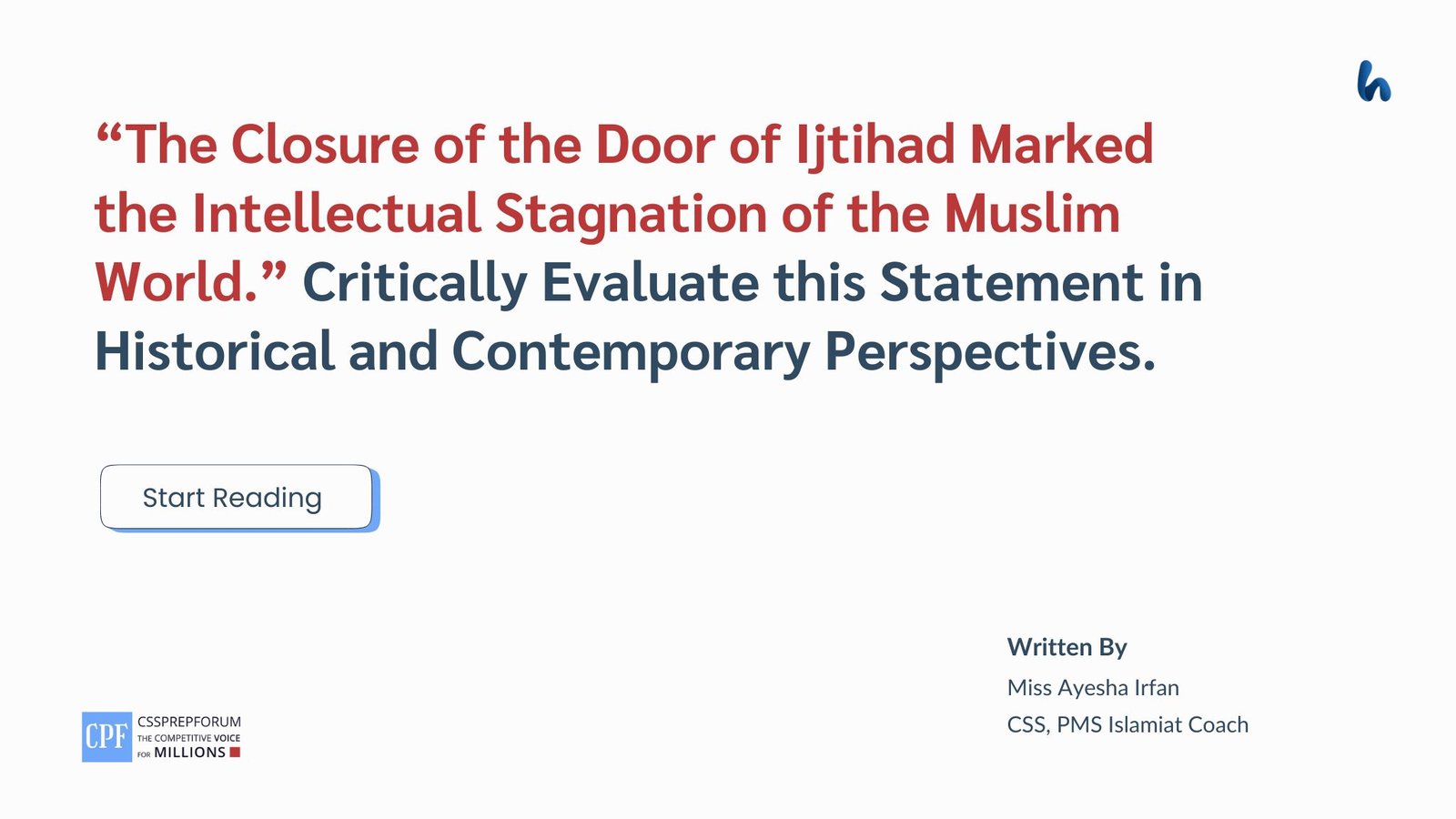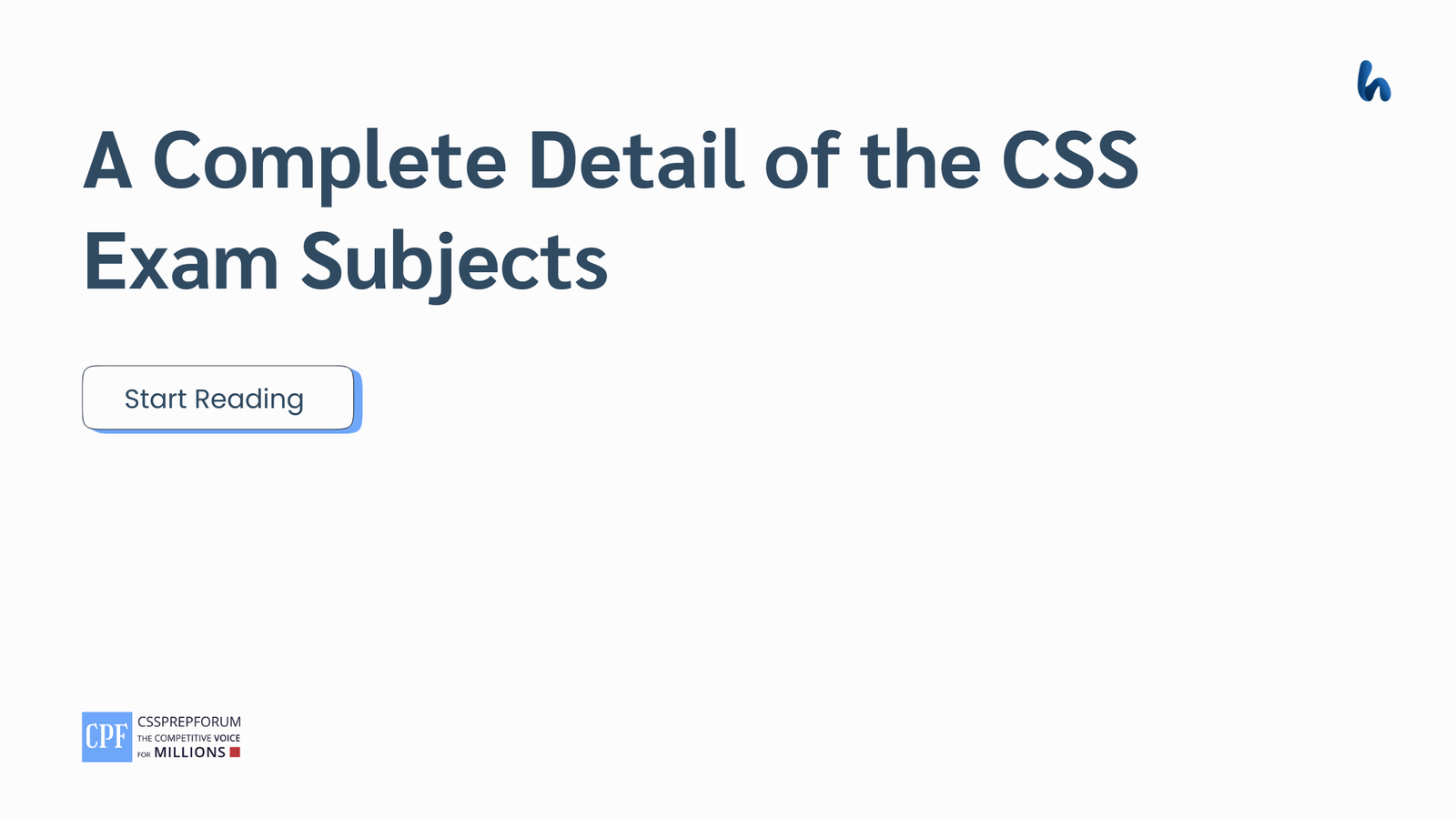CSS 2014 Solved Pakistan Affairs Past Papers | Factors Behind the Evolution of Muslim Society
The following question of CSS Pakistan Affairs 2014 is solved by Miss Iqra Ali, the best Pakistan Affairs Coach, on the guided pattern of Sir Syed Kazim Ali, which he taught to his students, scoring the highest marks in compulsory subjects for years. This solved past paper question is uploaded to help aspirants understand how to crack a topic or question, how to write relevantly, what coherence is, and how to include and connect ideas, opinions, and suggestions to score the maximum.

Question Breakdown
In this question, the examiner has asked for an analytical discussion on the factors contributing to the development of Muslim society in the Sub-continent. To secure high marks, the candidate should provide a well structured answer. Begin with a brief introduction contextualizing the arrival of Islam in Sub-Continent and its transformative impact on local society and then tracing the earlier influences of all the traders, missionaries, and invaders. Then conclude the answer by critically analyzing the question.
Outline
1-Introduction
- ✓ The spread of Islam brought profound changes in the region’s social fabric, influencing its governance, trade, education, and cultural identity.
- ✓ Various factors like migration, religious movements, political patronage, and educational reforms contributed to the establishment of a vibrant and enduring Muslim society in the region.
2- What were the factors which played significant role in the evolution and growth of Muslim society in the sub-continent?
- ✓ Early Spread of Islam
- Arab Traders and Missionaries
- The role of Arab merchants in coastal areas (Malabar, Gujarat) introducing Islamic values.
- Sufi missionaries and their contribution to spreading Islam among diverse communities.
- Military Conquests
- Muhammad bin Qasim’s conquest of Sindh in 711 AD established the first Muslim foothold.
- Integration of Islamic governance systems with local administration.
- Adaptation to Local Cultures
- Syncretism between Islamic and local traditions facilitated wider acceptance.
- Arab Traders and Missionaries
- ✓ Political Patronage
- Delhi Sultanate (1206–1526)
- Consolidation of Islamic rule under rulers like Qutb-ud-din Aibak and Alauddin Khilji.
- Introduction of Persian culture, art, and administration in governance.
- Mughal Empire (1526–1857)
- Akbar’s policy of religious tolerance and Sulh-i-Kul (universal peace).
- Promotion of architecture, literature, and a unified socio-political system.
- Aurangzeb’s stricter Islamic policies and their impact on Muslim identity.
- Role of Regional Muslim States
- Influence of regional Muslim rulers like the Deccan Sultanates and Bengal Nawabs.
- Delhi Sultanate (1206–1526)
- ✓ Religious and Educational Movements
- Sufi Orders
- Chishti, Suhrawardi, and Qadiri orders’ contributions to Islamic spirituality.
- Khanqahs (Sufi centers) as hubs of religious learning and community welfare.
- Aligarh Movement
- Sir Syed Ahmad Khan’s advocacy for modern education and scientific thinking.
- Establishment of Aligarh Muslim University as a center for Muslim intellectual growth.
- Deoband and Nadwa Movements
- Role in preserving Islamic theology and tradition.
- Emphasis on bridging traditional Islamic knowledge with contemporary challenges.
- Sufi Orders
- ✓ Socio-Economic Contributions
- Trade and Commerce
- Muslim traders’ dominance in Indian Ocean trade routes.
- Introduction of new technologies, banking systems, and market structures.
- Cultural Integration
- Flourishing of Urdu as a unifying language of Muslims.
- Contributions in art, architecture (Taj Mahal, mosques), and literature.
- Community Cohesion
- Establishment of waqf (charitable trusts) for social welfare.
- Role of mosques as centers of community organization.
- Trade and Commerce
3-Conclusion

Answer to the Question
Introduction
The evolution of Muslim society in the Subcontinent is a fascinating narrative of cultural fusion, political transformation, and spiritual awakening. From the early days of Arab traders and Sufi missionaries to the grandeur of the Mughal Empire, the growth of Islam in the region was not merely a religious shift but a profound reshaping of society. The arrival of Islam, through both conquest and peaceful exchange, laid the foundation for a community that embraced both tradition and innovation, seamlessly integrating Islamic principles with local customs and practices. Meanwhile, this adaptability allowed Islam to take root in a diverse and pluralistic society, where it coexisted with indigenous cultures while contributing to a rich mosaic of art, literature, and governance. Key factors such as military conquests, political patronage, and religious movements were instrumental in shaping Muslim society. Likewise, the early military conquests, led by figures like Muhammad bin Qasim, introduced Islamic governance, while subsequent dynasties, including the Delhi Sultanate and the Mughals, fostered a climate of political stability and cultural flourishing. Simultaneously, Sufi missionaries played a crucial role in spreading Islam through their inclusive approach and spiritual teachings. Together, these elements helped create a vibrant Muslim society that contributed to the Subcontinent’s historical, social, and cultural development, leaving an indelible legacy that continues to resonate today.
What were the factors which played significant role in the evolution and growth of Muslim society in the sub-continent?
A- Early Spread of Islam
- Arab Traders and Missionaries
Furthermore, the early spread of Islam in the Subcontinent was largely driven by the efforts of Arab traders and missionaries, who played a key role in introducing the faith to coastal regions such as Malabar, Gujarat, and Sindh. By the 7th century, Arab merchants had established thriving trade routes, connecting the Arabian Peninsula with the Indian Ocean, and facilitated not only the exchange of goods but also the exchange of ideas and beliefs. Through their interactions with local communities, these traders helped to plant the seeds of Islam in the Subcontinent. Sufi missionaries, with their emphasis on spiritual egalitarianism and compassion, further advanced the spread of Islam during the 12th and 13th centuries. Later, the Chishti, Suhrawardi, and Qadiri Sufi orders became central to this expansion, with Sufis engaging deeply with local populations, often in rural areas, and fostering interfaith dialogue. So, this peaceful propagation of Islam through trade and spiritual teachings proved effective, as it transcended socio-economic barriers and attracted people from various backgrounds, including both urban and rural communities. Today, estimates suggest that around 15-20% of India’s population follows Islam, a testament to the enduring legacy of these early exchanges. The spread of Islam through these means not only laid the foundation for Muslim society but also facilitated the integration of Islamic cultural and religious values into the diverse fabric of the Subcontinent.
- Military Conquests
Meanwhile, military conquests played a crucial role in establishing Muslim rule in the Subcontinent, beginning with Muhammad bin Qasim’s invasion of Sindh in 711 AD. This marked the first significant Muslim presence in the region. Subsequent invasions by the Delhi Sultanate (1206–1526) and the Mughal Empire (1526–1857) further solidified Muslim control over much of northern and central India. By the early 16th century, the Mughal Empire expanded to nearly 2 million square kilometers, creating a lasting legacy. Therefore, these conquests introduced Islamic governance, legal systems, and Persian as the language of administration. The Delhi Sultanate’s establishment brought cultural and architectural transformations, while the Mughal Empire fostered an era of artistic, architectural, and intellectual growth, leaving an indelible mark on the region’s social and political fabric. So, these military campaigns not only expanded territories but also integrated Islamic traditions with local cultures, shaping the Muslim identity in the Subcontinent for centuries.
- Adaptation to Local Cultures
Henceforth, the adaptation to local cultures was vital for the growth of Muslim society in the Subcontinent, as it ensured Islam’s acceptance within a diverse and pluralistic region. Muslim rulers, traders, and Sufi saints embraced a spirit of inclusivity, blending Islamic traditions with indigenous customs. This integration was particularly evident in art, language, and architecture. For instance, the development of Indo-Islamic architecture, exemplified by structures like the Qutub Minar and the Taj Mahal, reflected a harmonious fusion of Persian, Central Asian, and Indian styles. The emergence of Urdu, a blend of Persian, Arabic, and local dialects, became a unifying language for millions. Next, sufi saints, such as Khwaja Moinuddin Chishti, attracted large followings by promoting messages of equality and spiritual harmony, transcending caste and class barriers. By the 16th century, Islam had become deeply rooted, with over 25% of the Subcontinent’s population identifying as Muslim, underscoring this successful cultural synthesis.
B- Political Patronage
- Delhi Sultanate (1206–1526)
Nonetheless, the Delhi Sultanate (1206–1526) played a pivotal role in the establishment and growth of Muslim society in the Subcontinent through political patronage. Under the rule of dynasties such as the Mamluks, Khiljis, Tughlaqs, and Lodhis, the Sultanate created a centralized administration that introduced Islamic governance, legal systems, and taxation policies. Further, Persian became the official language of the court, fostering intellectual and cultural exchanges. This era also saw the construction of monumental architectural works, including the Qutub Minar and Alai Darwaza, which showcased Islamic artistry blended with local styles. In addition to it, the Sultanate promoted agriculture and trade, connecting the Subcontinent to global markets through the Silk Road and Indian Ocean networks. By the late 13th century, the Sultanate controlled over 1.5 million square kilometers of territory, fostering a diverse population under its rule. This period laid the foundation for a flourishing Muslim identity that would influence the region for centuries.
- Mughal Empire (1526–1857)
Nevertheless, the Mughal Empire (1526–1857) provided extensive political patronage that shaped the cultural, social, and administrative identity of Muslim society in the Subcontinent. Under rulers like Akbar, Jahangir, Shah Jahan, and Aurangzeb, the empire established a centralized administration, implementing an efficient revenue system and a uniform legal framework rooted in Islamic principles. The empire’s territory, at its peak under Aurangzeb, spanned nearly 4 million square kilometers, encompassing a diverse population. Subsequently, the Mughals were renowned for their patronage of arts and architecture, commissioning iconic structures like the Taj Mahal, Jama Masjid, and Red Fort, which symbolized a blend of Persian, Indian, and Central Asian styles. They also promoted Persian and Urdu literature, contributing to a rich cultural legacy. Akbar’s policy of religious tolerance, exemplified by the Din-i-Ilahi, fostered harmony among communities. This era marked a golden age of Muslim influence, leaving an enduring imprint on the Subcontinent’s history.
- Role of Regional Muslim States
Hence, regional Muslim states played a significant role in fostering the growth of Muslim society in the Subcontinent by promoting governance, culture, and trade at local levels. Kingdoms like the Bahmani Sultanate (1347–1527) in the Deccan and the Bengal Sultanate (1352–1576) were instrumental in spreading Islamic traditions and creating centers of learning and cultural exchange. The Bahmani rulers established institutions such as the Madrasa of Bidar, enhancing education and promoting Persian and Arabic literature. Simultaneously, the Bengal Sultanate, with its flourishing maritime trade, linked the region to Southeast Asia and the Islamic world, bolstering economic prosperity. These states also contributed to architecture, with the Charminar in Hyderabad and Adina Mosque in Bengal standing as enduring symbols of their legacy. At their peak, these regional powers governed vast territories, influencing millions of people. Their independent yet interconnected contributions enriched the Subcontinent’s Muslim heritage and reinforced its socio-political fabric.
C- Religious and Educational Movements
- Sufi Orders
Besides, sufi orders played a transformative role in the religious and educational development of Muslim society in the Subcontinent. Renowned Sufi saints, such as Khwaja Moinuddin Chishti of the Chishti Order, Baba Farid of the Suhrawardi Order, and Shah Jalal in Bengal, emphasized spiritual devotion, equality, and social harmony, transcending barriers of caste and creed. Next, these orders established khanqahs (spiritual centers) that served not only as places of worship but also as hubs for education, teaching Quranic studies, Persian literature, and ethics. By the 16th century, the Chishti Order alone had inspired millions, fostering a sense of community and spiritual awakening. Sufis’ inclusive approach attracted large followings, particularly among marginalized groups, further spreading Islam’s teachings. Later, many regional rulers also patronized Sufi saints, amplifying their influence. This spiritual and educational outreach strengthened the moral and intellectual foundations of Muslim society, leaving an enduring legacy across the Subcontinent.
- Aligarh Movement
Consequently, the Aligarh Movement, spearheaded by Sir Syed Ahmad Khan in the late 19th century, was pivotal in transforming Muslim society in the Subcontinent by emphasizing modern education and socio-political awareness. Establishing the Muhammadan Anglo-Oriental College in 1875, which later became Aligarh Muslim University in 1920, Sir Syed sought to integrate Western scientific knowledge with Islamic values. By 1881, the college had enrolled over 300 students, fostering a generation of Muslim professionals and leaders. The movement encouraged Muslims to embrace modern education to compete with other communities and counteract their post-1857 marginalization. So, it also instilled a sense of unity, advocating for political engagement and cultural revival. The Aligarh Movement laid the groundwork for the intellectual and political awakening of Muslims, influencing the demand for a separate homeland.
- Deoband and Nadwa Movements
Additionally, the Deoband and Nadwa movements emerged in the late 19th century as influential reformist efforts aimed at revitalizing Islamic education and preserving Muslim identity in the Subcontinent. The Deoband movement, founded in 1866 with the establishment of Darul Uloom Deoband, focused on traditional Islamic scholarship, graduating over 15,000 students by the early 20th century. Meanwhile, it emphasized Quranic studies, Hadith, and Islamic jurisprudence to counter Western influences. In contrast, the Nadwa Movement, initiated in 1894 through the Nadwatul Ulama in Lucknow, advocated for a balanced approach, integrating traditional Islamic learning with modern subjects. By 1910, Nadwa had become a hub for intellectual discourse, drawing Muslim scholars from across India. Together, these movements played a crucial role in preserving Islamic values and empowering the Muslim community during colonial rule.
D- Socio-Economic Contributions
- Trade and Commerce
In the same context, trade and commerce significantly contributed to the socio-economic growth of Muslim society in the Subcontinent, fostering prosperity and cultural exchange. Muslim traders established thriving trade networks, connecting South Asia with Central Asia, the Middle East, and beyond. Cities like Delhi, Lahore, and Surat became bustling centers of commerce under Muslim rule, with exports of textiles, spices, and precious metals dominating global markets. By the 17th century, Surat alone accounted for nearly 25% of India’s foreign trade. Islamic principles of business ethics, such as fairness and trust, strengthened partnerships and encouraged economic stability. Additionally, waqf (endowments) financed public welfare projects, including schools, mosques, and hospitals, enhancing societal development. This vibrant trade activity integrated the Subcontinent into the global economy, leaving a lasting legacy.
- Cultural Integration
In the same manner, cultural integration under Muslim rule profoundly shaped the socio-economic landscape of the Subcontinent, fostering unity amid diversity. Through a blend of Persian, Central Asian, and local traditions, Muslims introduced new art forms, music, and architecture, evident in iconic structures like the Taj Mahal and Fatehpur Sikri. The development of Urdu, blending Persian, Arabic, and Indian dialects, became a unifying language for millions, facilitating communication and literary growth. Furthermore, festivals like Basant in Punjab showcased the fusion of Islamic and local traditions. By the 16th century, this cultural synthesis had enriched trade and crafts, with Mughal patronage boosting textile production, which constituted over 40% of India’s global exports. Such integration strengthened communal ties and contributed to a vibrant, diverse society.
- Community Cohesion
Afterward, Muslim rule in the Subcontinent significantly enhanced community cohesion by promoting shared spaces and inclusive practices. Institutions like mosques, madrasas, and Sufi khanqahs became centers of spiritual guidance, education, and social interaction, fostering unity across diverse communities. Further, the waqf system provided resources for public welfare, funding schools, hospitals, and waterworks, benefiting all, regardless of religion. For instance, by the 17th century, Mughal cities like Agra and Lahore thrived as cosmopolitan hubs, housing populations exceeding 500,000, with people of different faiths coexisting and collaborating in trade and crafts. Celebrations of Islamic festivals alongside local traditions fostered harmony, while the integration of laws like the sharia and local customs ensured equitable governance. These efforts strengthened bonds and created a legacy of social solidarity.
Conclusion
Indeed, the evolution and growth of Muslim society in the Subcontinent was a multifaceted process driven by a combination of military conquests, cultural adaptation, political patronage, and socio-economic contributions. Through the efforts of Arab traders, Sufi missionaries, and regional rulers, Islam became deeply rooted in the region, fostering a rich cultural and intellectual heritage. The Aligarh Movement and educational initiatives, such as those from Deoband and Nadwa, played pivotal roles in empowering the Muslim community with modern knowledge and political awareness. Additionally, the flourishing of trade, commerce, and cultural integration created a cohesive society that transcended religious and social divides. The legacy of these contributions continues to shape the region, reflecting the enduring influence of Muslim civilization in the sub continent’s history.
CSS 2014 Solved Pakistan Affairs
CSS Solved Past Papers’ Essays
Looking for the last ten years of CSS and PMS Solved Essays and want to know how Sir Kazim’s students write and score the highest marks in the essays’ papers? Then, click on the CSS Solved Essays to start reading them.
CSS Solved Essays
CSS Solved General Science & Ability Past Papers
Want to read the last ten years’ General Science & Ability Solved Past Papers to learn how to attempt them and to score high? Let’s click on the link below to read them all freely. All past papers have been solved by Pakistan’s top CSS GSA coach having the highest score of their students.
General Science & Ability Solved Past Papers

